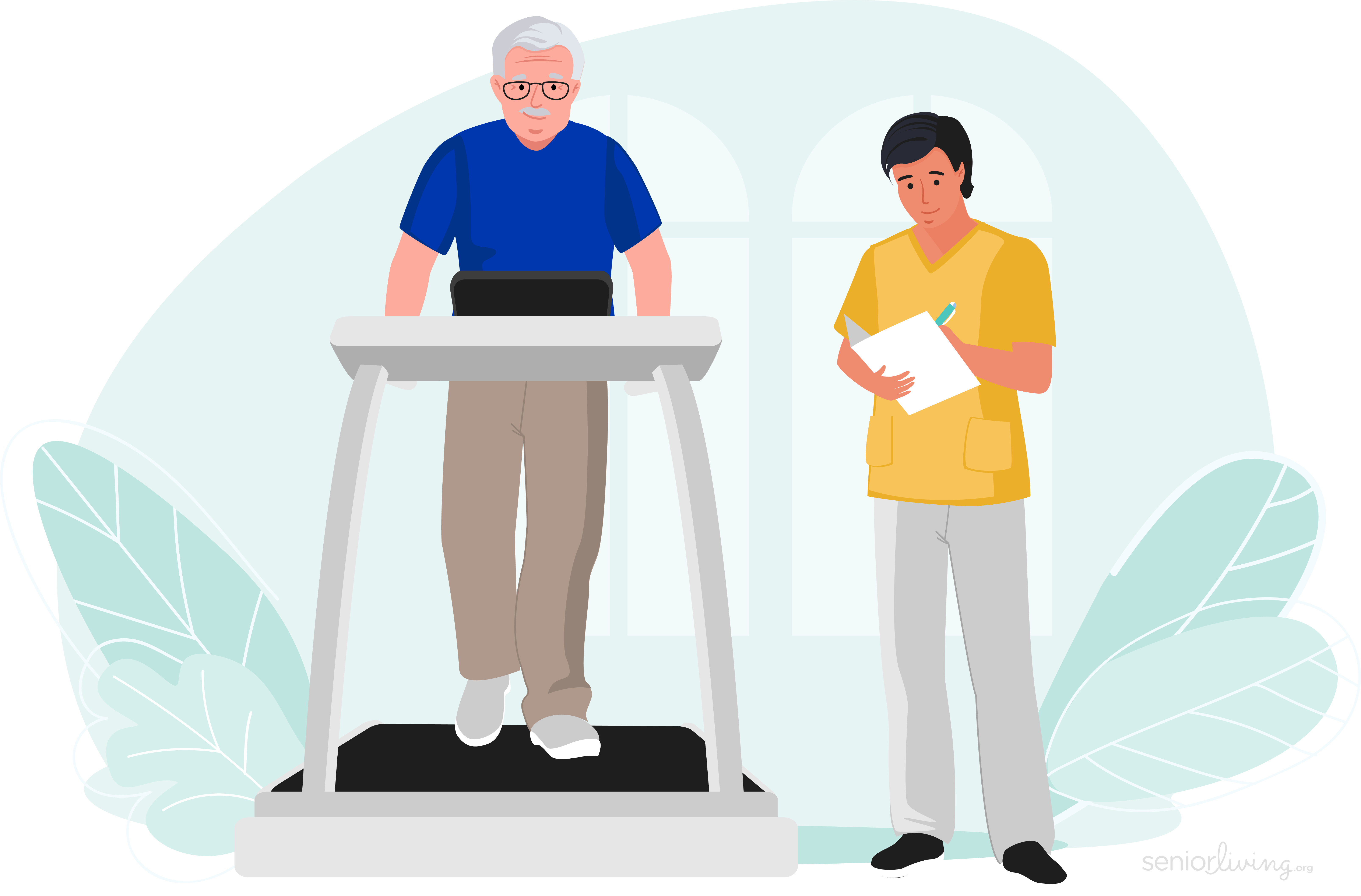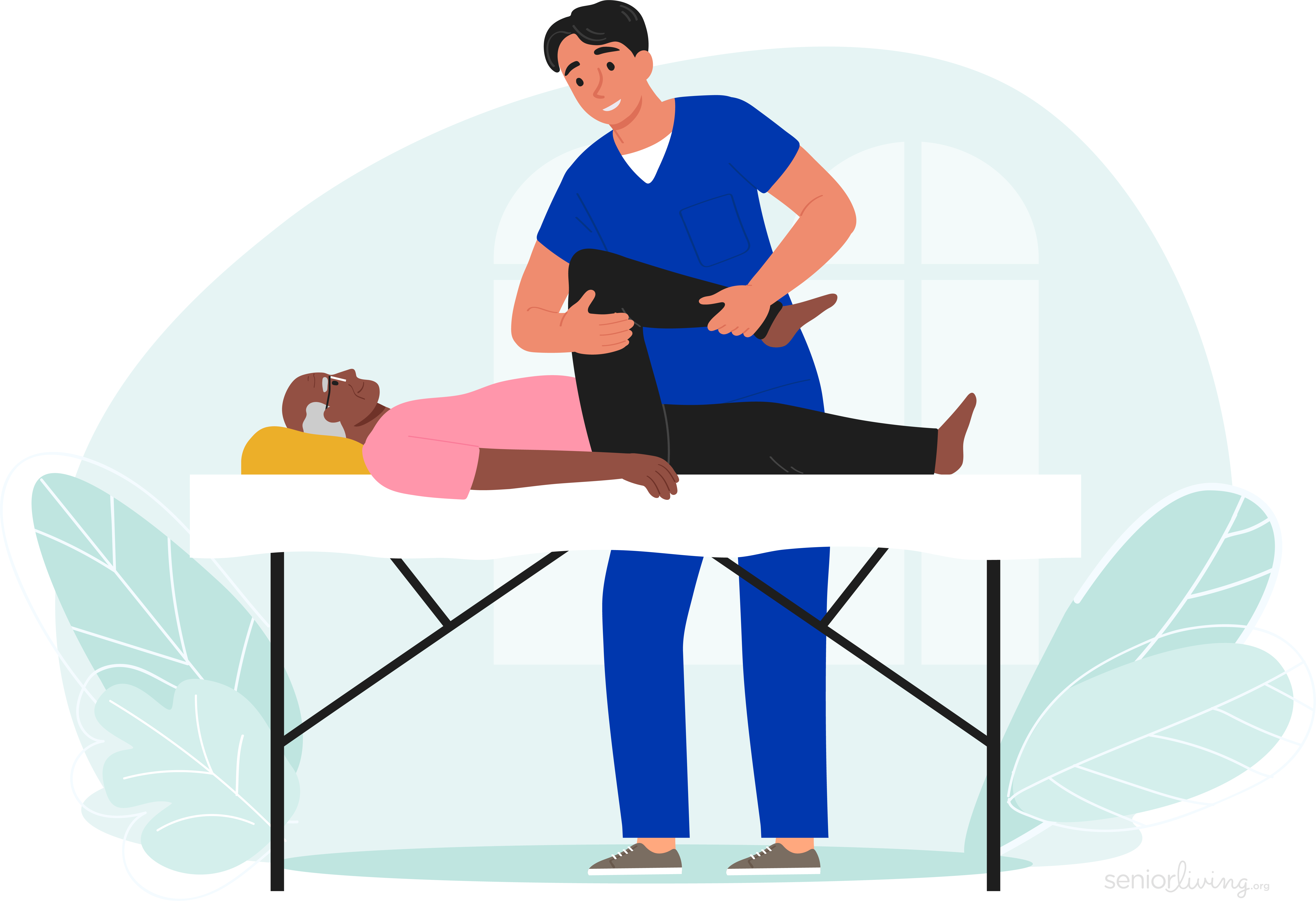Physical Therapy for Seniors
A 2025 Guide to Physical Therapy for Seniors
SeniorLiving.org is supported by commissions from providers listed on our site. Read our Editorial Guidelines
When you suffer an injury or illness, or experience chronic pain, navigating your healing journey can be overwhelming. Physical therapy (PT) designed for seniors can help relieve pain, help you move better, and strengthen your muscles. Using exercises, massages, and treatments that incorporate physical stimuli1 helps you get back to doing everyday tasks more comfortably. The goal of physical therapy is to facilitate your return to wellness and to enable you to participate in regular activities more quickly and easily.
Physical therapy for older adults prioritizes your desire to maintain independence. In addition to preserving independence, the recipient is likely to improve their overall mobility and possibly prevent future injuries.2 The senior population benefits from working with physical therapists because these professionals use evidence-backed, targeted programs to help older adults in their recovery.
Table of Contents
- What Are the Benefits of Physical Therapy for Seniors?
- What Will My Physical Therapist Do?
- How Do I Know If a Physical Therapist Is Good?
- How Many Times a Week Should I Go to Physical Therapy?
- Can I Do Physical Therapy at Home?
- What Are the Types of Physical Therapy?
- What Conditions Are Helped with Physical Therapy?
- How Do I Find Physical Therapists for Seniors Near Me?
What Are the Benefits of Physical Therapy for Seniors?
Our health changes as we grow older. Because older adults often lose strength and stability when they’re over 65, physical therapy can address their unique needs. For example, a decrease in muscle strength and challenges performing physical activities come with aging.
FYI: Note that PT is a popular abbreviation for both physical therapy and physical therapist.
Physical therapy builds up strength and endurance. It can also help to reduce pain and can improve physical functions in many areas, including flexibility, strength, balance, and coordination.3 It’s valuable for seniors, especially after illness or injury, to go to a physical therapist to accelerate their rate of recovery.
What Will My Physical Therapist Do?

During the first assessment, the PT will discuss with you what happened and the limiting effects of this illness or injury. They will evaluate your level of functioning by testing how you perform certain activities, how you reach or grasp, or how you walk or climb, depending on where you’re having a challenge. They will also determine your pain level. Some will perform manual therapy near an injury like unlocking a stiff joint. Or they might do soft-tissue work to help with healing.
Then, they’ll work with you to create a treatment plan based on your individual needs. It will include your personal goals, what activities you might avoid, and any lifestyle changes you need to make temporarily to improve recovery. They will likely guide you with special exercises to do on your own to improve circulation and restore function.
The PT is tasked with designing a care plan for you. Suggested techniques could involve exercises such as stretching, water aerobics, or walking. They could also recommend hands-on treatments to address your symptoms. The ongoing objective for a PT is to guide and monitor your progress, and adjust goals as needed, with the hope of maximizing your abilities.
FYI: Want to live in a community that promotes staying active as you age? Check out our guide to active senior living communities.
How Do I Know If a Physical Therapist Is Good?
It makes sense to seek someone kind, empathetic, and knowledgeable, but you also want to look for something else in a good physical therapist. PTs will generally tailor their plans to your specific limitations and needs, but they should also be recommending evidence-based, effective treatments that draw from the latest research, especially for seniors.
Research reveals that treatments should be active, incorporating strengthening and stretching exercises. For example, ultrasound, a passive treatment, has shown few results, yet is still being used by PTs across the country.
Exercise has been proven to successfully treat everything from low back pain to knee ligament injuries, according to decades of research. If your PT is recommending only passive treatments like heat packs or ultrasound therapy, that may be fine at the beginning. But be sure to consider their overall approach to your treatment and see if the PT you’re going to is up to date on recent findings in the field.4
How Many Times a Week Should I Go to Physical Therapy?
A typical order usually requires two or three physical therapy sessions per week. The therapy sessions could last for four, six, or 12 weeks, depending on the particulars of the situation. Not adhering to the program can slow down your results.
The reason patients don’t follow up is often because of accessibility. A recent scientific study revealed the common obstacles people face that prevent them from going to their sessions.5 These barriers to treatment include the distant locations of clinics, transportation challenges, long wait times, and the cost. Although the study focused on the homeless and poor, these are the same barriers to treatment among the general population as well.
Can I Do Physical Therapy at Home?
Few PTs make at-home visits, but some do. Most physical therapists will ask you to do exercises at home to complement their sessions. Because they can’t remind you to do the exercises or see if you’re performing them correctly, leveraging new technology can help. A top AI-driven health app for physical therapists from Exer Health can send SMS reminders to patients to do their exercises. Patients record themselves from their tablet or smartphone performing the exercises and use the platform to send the videos to their PT.
The PT views the footage and determines the patient’s mobility, strength, and range of motion from afar. As PTs have to rely on their patient’s participation and commitment, being able to leverage technology through software can help PTs assist their patients even more. After receiving reliable data, PTs can then tweak and adjust the exercise or give advice on how to do exercises better for optimal results.
FYI: To learn more about the ways seniors use technology to enhance everyday life, check out our guide to assistive technology devices.
What Are the Types of Physical Therapy?

- Manual therapy is foundational. This hands-on technique might include massage, mobilization, or manipulation. By using their hands, the PT can help reduce pain, minimize muscle tension, and improve joint movement. This can make your circulation better and help you regain flexibility.
- Cold therapy is used in acute, soft-tissue injuries in order to quickly numb pain and reduce swelling and inflammation.
- Heat therapy is used to relax muscles and stretch tendons and ligaments. Heat relieves muscle tension and promotes circulation. This is useful for loosening stiff joints from osteoarthritis or other conditions in which you've become immobilized.
- Therapeutic exercise encompasses various kinds of exercise. Aquatic therapy uses water to treat diseases and to maintain health. It’s often recommended to heal soft tissues, increase blood flow, and relax the entire body. Your PT might recommend stretching, weight training, or resistance band training. Or maybe your PT will want you to practice balance exercises and work on aerobic conditioning to improve your functional abilities.
- Electrical stimulation uses electrical current to create a desired effect in the body. For instance, electrical currents can scramble pain signals. Electrical stimulation is used to contract muscles in stroke victims and those with arthritis.
- Ultrasound therapy uses sound waves to reduce muscle spasms and relax the muscles before and after exercise. A scientific study on ultrasound found some evidence supporting therapeutic ultrasound for those with arthritis in the knee.6 But due to the lack of ultrasound’s efficacy in many other studies, although it’s been a popular technique for years, you might ask your PT to use it as an adjunct treatment and not a primary treatment if at all.
Physical therapists will use a variety of techniques to help older adults regain good health and mobility. They will also educate patients on how to best perform daily tasks, protect their body from re-injury, perform exercises at home, and make their home a safer place.
Did You Know? The long-recommended RICE method, which is a treatment that involves rest, icing, compression, and elevation, has been called into question lately as evidence has shown rest might slow down the healing process
What Conditions Are Helped with Physical Therapy?
Physical therapy can help individuals in various stages of recovery or those looking for preventive measures. Some situations where physical therapy would be beneficial include:
- Orthopedic injuries like fractures and sprains
- Osteoarthritis
- Surgical recovery
- Spinal or joint pain such as in the knee, back, shoulder, or wrist
- Rehabilitation following a heart attack or stroke
- Neurological disorders such as multiple sclerosis or cerebral palsy
- Muscular atrophy, or a loss of muscle tissue from immobility
Here are more specific ways PTs work with seniors to improve how they feel and function when they’re battling medical conditions:
- Many people over age 65 have spinal arthritis. PTs can help offset future symptoms by using aquatic exercises, hot packs, electrical stimulation, and other techniques.7
- For stroke patients, PTs use constraint-induced movement therapy, restraining the unaffected side to force the affected side to compensate by working harder. Other techniques employed include using motor imagery and mental practice to rehearse movements without actually doing them. This stimulates that part of your brain that controls movement.8
- Patients with Parkinson's disease work with a PT to perform gait and balance training, resistance training, and controlled exercises.
- Older adults experiencing incontinence are taught pelvic floor exercises (known as Kegel exercises) that strengthen and retrain muscles to better control the bladder and improve muscle response.
- PTs help Alzheimer's patients with aerobic exercise training, which can improve memory and delay further cognitive decline. Long-term, regular exercise has been shown to be clinically effective in delaying the onset of age-related memory loss. PTs also use “mirroring” where the PT serves as a mirror, showing the patient how to move. Other techniques include dancing and gardening, which help patients remember certain types of movements.9
- Chronic obstructive pulmonary disease (COPD), which causes difficulty breathing, is addressed with aerobic exercise training to reduce the time someone experiences shortness of breath by reducing fatigue, training the diaphragm, and increasing lung capacity.10
Physical therapy can be given to seniors in a wide variety of living situations. You don’t need to go to hospitals or clinics to receive care. Here are some settings in which you can receive physical therapy:
How Do I Find Physical Therapists for Seniors Near Me?
Physical therapists work in hospitals, rehabilitative care centers, nursing homes, and private practices.
If you’re looking for a physical therapist for seniors in your area, ask your health care provider or a trusted friend. They may be able to recommend one who’s perfect for you. Otherwise, you can use Google to search for “physical therapist for seniors near me” to get local results.
The American Physical Therapy Association (APTA) is a good resource too. APTA is a professional organization of over 100,000 physical therapists, physical therapist assistants, and physical therapy students. To go directly to the APTA directory, type in the search bar “ChoosePT.com” and discover PTs near you. The tool enables you to also refine your search by a specific condition, telehealth, and other filters.
Final Thoughts
As you can see, physical therapy can help seniors in many areas of healthcare and in a range of settings. If you're recovering from surgery or an illness, or living with a disease, ask your doctor about physical therapy. PT can give you back your independence by increasing your mobility and making daily tasks and overall living easier and more pleasurable.
National Library of Medicine. (2023). Physical therapy.
VeryWell Health. (2021). Geriatric Physical Therapy and Types of Exercises for Older Adults.
Mayo Clinic. (2025). Physical Therapy Services & Treatments.
New York Times. (2023). What to Look for in a Physical Therapist.
National Library of Medicine. (2019). Enhancing Access to Physical Therapy Services for People Experiencing Poverty and Homelessness: The Lighthouse Pilot Project.
American Academy of Pain Medicine. (2019). Therapeutic Ultrasound for Chronic Pain Management in Joints: A Systematic Review.
WebMD. (2022). The Benefits of Physical Therapy for Older Adults.
National Library of Medicine. (2023). Progress in the clinical application of constraint-induced therapy following stroke since 2014.
National Library of Medicine. (2020). Physical exercise in the prevention and treatment of Alzheimer's disease.
National Library of Medicine. (2017). Physiotherapy in Patients with Chronic Obstructive Pulmonary Disease.

